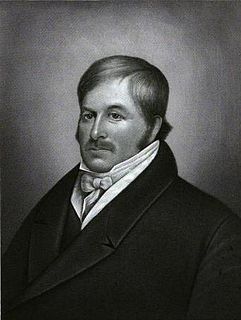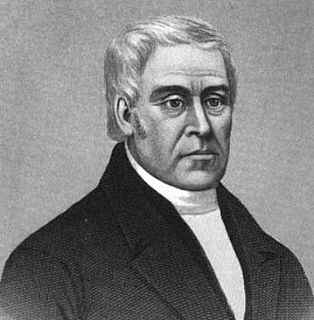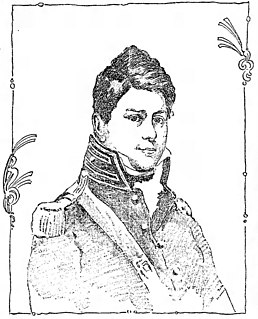Related Research Articles

The Territory of Michigan was an organized incorporated territory of the United States that existed from June 30, 1805, until January 26, 1837, when the final extent of the territory was admitted to the Union as the State of Michigan. Detroit was the territorial capital.

The Indiana Territory was created by a congressional act that President John Adams signed into law on May 7, 1800, to form an organized incorporated territory of the United States that existed from July 4, 1800, to December 11, 1816, when the remaining southeastern portion of the territory was admitted to the Union as the state of Indiana. The territory originally contained approximately 259,824 square miles (672,940 km2) of land, but its size was decreased when it was subdivided to create the Michigan Territory (1805) and the Illinois Territory (1809). The Indiana Territory was the first new territory created from lands of the Northwest Territory, which had been organized under the terms of the Northwest Ordinance of 1787. The territorial capital was the settlement around the old French fort of Vincennes on the Wabash River, until transferred to Corydon near the Ohio River in 1813.

Solomon Sibley was an American politician and jurist in the Michigan Territory who became the first mayor of Detroit, Michigan.

James Witherell was an American politician. He served as a United States Representative from Vermont and as a Judge of the Supreme Court for the Territory of Michigan.
John Griffin was an American judge. He was one of the original judges of the Supreme Court of Michigan Territory.

The Sixth Michigan Territorial Council was a meeting of the legislative body governing Michigan Territory, known formally as the Legislative Council of the Territory of Michigan. The council met in Detroit in two regular sessions, one extra session, and one special session between January 7, 1834, and August 25, 1835, during the terms of George B. Porter and Stevens T. Mason as territorial governors.
The Michigan Territorial Council, known formally as the Legislative Council of the Territory of Michigan, was the legislative body of the Territory of Michigan from 1824 to 1835, when it was succeeded by the Michigan Legislature in anticipation of Michigan becoming a U.S. state. A session of the council including only members from what would become Wisconsin Territory met in 1836.

The Fifth Michigan Territorial Council was a meeting of the legislative body governing Michigan Territory, known formally as the Legislative Council of the Territory of Michigan. The council met in Detroit in two regular sessions between May 1, 1832, and April 23, 1833, during the term of George B. Porter as territorial governor.
The Fourth Michigan Territorial Council was a meeting of the legislative body governing Michigan Territory, known formally as the Legislative Council of the Territory of Michigan. The council met in Detroit in two regular sessions between May 11, 1830, and March 4, 1831, during the terms of Lewis Cass and George B. Porter as territorial governor.
The Third Michigan Territorial Council was a meeting of the legislative body governing Michigan Territory, known formally as the Legislative Council of the Territory of Michigan. The council met in Detroit in two regular sessions between May 5, 1828, and November 5, 1829, during the term of Lewis Cass as territorial governor.
The Second Michigan Territorial Council was a meeting of the legislative body governing Michigan Territory, known formally as the Legislative Council of the Territory of Michigan. The council met in Detroit in two regular sessions between November 2, 1826, and April 13, 1827, during the term of Lewis Cass as territorial governor.

Abraham Edwards was an American physician and politician in the U.S. state of Michigan. He served in the U.S. Army during the War of 1812 and was president of the Michigan Territorial Council for a majority of its existence.
William Henry Puthuff, also spelled Puthoff, was an American soldier, businessman, and politician who served in the War of 1812 and occupied a number of government positions in the Territory of Michigan. In his role as Indian agent at Michilimackinac, he engaged in a multi-year conflict with John Jacob Astor and his American Fur Company. He was a member of the First Michigan Territorial Council and died while attending its first session.

Hubert Lacroix or Le Croix was an American soldier, trader, and politician who fought in the War of 1812. He was captured by the British following the surrender of Detroit and saved from charges of treason by his friend, the Shawnee chief Tecumseh. Lacroix later served two terms as a member of the Michigan Territorial Council.
Wolcott Lawrence was an American jurist, businessman, and politician who served multiple terms on the Michigan Territorial Council.
Roger Sprague was an American businessman and politician in New York and the Territory of Michigan. He served in the New York State Assembly and on the Michigan Territorial Council.
Joseph Miller was an American pioneer and politician who served on the Michigan Territorial Council in 1825.
The 1823 Michigan Territorial Council election was held in the Territory of Michigan to elect the members of the territory's newly-formed legislative council.
The 1825 Michigan Territorial Council election was held in the Territory of Michigan to elect the members of the territory's legislative council.
The 1818 Michigan Territory general assembly referendum was held in the Territory of Michigan to determine whether a majority of the territory's freeholders favored the creation of a general legislative assembly to replace the system of governors and judges in effect at the time, as provided for by the Northwest Ordinance. The election was called by Territorial Governor Lewis Cass, and results showed a majority opposed changing the system of government.
References
- Carter, Clarence E., ed. (1943), The Territorial Papers of the United States, 11, Washington, D.C.: Government Printing Office, retrieved 2019-10-05
- Finkelman, Paul; Hershock, Martin J.; Taylor, Clifford W. (2006), The History of Michigan Law, Ohio University Press, retrieved 2019-10-01
- Gilpin, Alec (2002), The Territory of Michigan (1805-1837), Michigan State University Press, retrieved 2019-10-05
- Journal of the Legislative Council of the Territory of Michigan: First Session—First Council, Detroit: Sheldon and Reed, 1824, retrieved 2019-10-05– via HathiTrust
- Journal of the Legislative Council of the Territory of Michigan: Second Session—First Council, Detroit: Sheldon and Reed, 1825, retrieved 2019-10-14
- Legislative Council, State of Michigan (2017), Michigan Manual (2017–2018 ed.), Lansing: Legislative Service Bureau, ISBN 1-878210-06-8 , retrieved 2019-10-04
- State of Michigan (1874), Laws of the Territory of Michigan, 2, Lansing: W. S. George, retrieved 2019-10-04